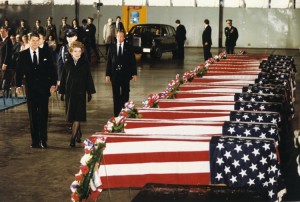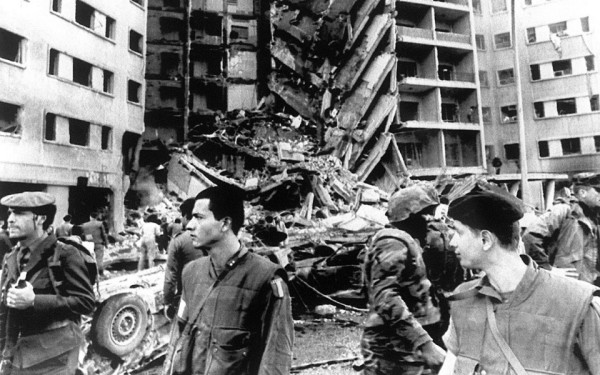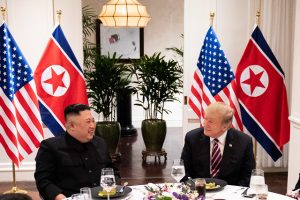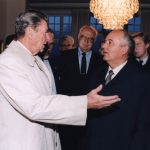by Augustus Richard Norton
Until 1:04 PM on April 18, 1983, Robert Clayton Ames was little known outside U.S. foreign policy and intelligence circles. On that day he died, along with 62 other casualties in and around the U.S. Embassy in Lebanon, then a familiar landmark on Beirut’s seaside corniche.
The building suffered devastating damage when a pickup truck laden with 2,000 pounds of explosives was driven into the lobby. Ames, the influential Director of the Near East and South Asia division within the CIA’s Directorate of Intelligence, was on a visit to Lebanon, which President Ronald Reagan declared a “strategic interest” for the U.S. following Israel’s game-changing invasion the prior year.
A former National Intelligence Officer, Ames’ intelligence assessments carried weight in Washington where he enjoyed access to Secretary of State George Shultz. He had arrived in Beirut in April 1983 carrying the outline of an agreement that would be announced the following month. Mediated between Israel and Lebanon by Shultz, the May 17 agreement called for the withdrawal of Israeli forces from Lebanon, but with the proviso that the Syrians would also withdraw their soldiers.
Hours before his death, Ames shared the details with Mustafa Zein, a longtime Lebanese confidante, a wielder of wasta (connections), which are far more important in Lebanon than institutions or laws. Zein urged irreverently that the agreement be printed on very thin paper so it might be used in the toilet. Ames enjoyed the joke, a hint of his own cynicism about the prospect that then-President Hafez al-Assad would yank his forces from Lebanon, particularly at a time when the high blown but mutually contentious hopes of Israel and the United States were deflating.
The agreement did accomplish one thing, perhaps its hidden motive: it helped repair a rupture in U.S.-Israeli relations that had been provoked by the clash of their rival agendas in Lebanon. Otherwise, Zein got it right.
Defective policy
One of the many virtues of Kai Bird’s impressive volume, The Good Spy: The Life and Death of Robert Ames, is that he offers a fine-grained, if sometimes gruesome account, of the destruction of the embassy as well as the broader tableau for U.S. engagement in a Middle East that would become more vicious and venomous.
The U.S. intervened in Lebanon in support of a political order that was being upended, in significant measure as a result of the rise of the large Shi’a community. It was this community that bore the brunt of brutish Israeli behavior that bred enmity to Israel and to its protective uncle. Ames and his fellow intelligence officers were deeply skeptical of U.S. policy in Lebanon. They worried about growing dangers, but their political masters were slow to grasp the reality. At the time, I felt that the understanding in the White House of the evolving situation in Lebanon lagged months behind the reality on the ground.

President Ronald Reagan and his wife, Nancy, walk by the flag-draped caskets of victims of the April 18, 1983, bombing of the U.S. Embassy in Beirut, Lebanon. Credit: Ronald Reagan Presidential Library
There were precedents for the deadly attack, including similar incidents in December 1981 when the Iraqi Embassy was demolished, and in November 1982 when an Israeli intelligence center near the southern city of Tyre was decimated. Yet, the scale of destruction came as a shock to U.S. policymakers. Bird reports that two vehicle barriers that might have impeded the April attack were gathering dust in a warehouse.
Credible evidence — reprised by Bird — points to Iran as the progenitor of the April attack as well as the even more massive bombings in October 1983 against the U.S. Marine Barracks and a building housing French Paratroopers that killed more than 300 soldiers. Bird offers new details about the role of the Iranian Revolutionary Guard officials in Lebanon, including Ali Reza Asgari, who he links to both attacks.
Iran found ready partners, especially among young militants inspired by the 1979 “Islamic Revolution,” including a young man by the name of Imad Mughniyeh, born in Tayr Dibbah (Bird mangles the name of the village) in southern Lebanon.
The notorious Mughniyeh (assassinated in Damascus in 2008), while not the mastermind according to Bird, did have a key hand in the embassy bombing. He is credited with lots of deadly mischief and terrorism in the ensuing years, but details remain murky, including in Bird’s account. As one retired Agency officer wryly notes, “when in doubt, and we are always in doubt about this, blame Mughniyeh.”
A very good spy
Ames joined the CIA in late 1960. The slow-paced early chapters of the book offer glimpses of his early career as a spy and his pre-CIA service as a young draftee assigned to a secluded intelligence station in Eritrea where his fascination with Arabic and the Arab world on the opposite shore of the Red Sea emerged.
All of Ames’ Agency assignments were in challenging locales. He served in Aden, in 1968-69, in the waning days of British control and the first and violent days of the former protectorate’s independence and subsequent estrangement from the West. Even so, he proved an adept recruiter of sources, a talent for which he gained admiration around the Agency.
He subsequently served in Saudi Arabia and Lebanon — countries affected profoundly but differently by the magnetic appeal of Arab nationalism, especially from the lips of Egypt’s Gamal Abdel Nasser. Ames kept his emotions in his pocket, like when he witnessed a botched execution in Saudi Arabia and simply murmured to a colleague that they should leave. That was, he reasoned, how things were done in Arabia.
He was not immune to the fervor of the period though. When Nasser was felled by a heart attack in 1970, he composed a poem reading in part: “A light went out, an era ended.” And so it had. Nasser’s exit opened the way for contending Arab dreams based on state nationalism or the idealism of Islamism.
After his death, he was described by CIA Director William Casey as “the closest thing to an irreplaceable man”. In part, Casey’s tribute honored Ames for his success in penetrating the Palestinian resistance in the early 1970s, which he did largely on his own initiative, retrospectively gaining the blessing of the CIA Director. His key source was the flamboyant Ali Hassan Salameh, who Yasser Arafat trusted and entrusted with maintaining a conduit to the United States.
Salameh, who headed the organization’s intelligence apparatus, was a rival of Palestinian Liberation Organization (PLO) chieftain Salah Khalaf (Abu Iyad), creator of Black September. Salameh headed Force 17 (Mughniyeh had once been a member), the Fatah Special Ops unit, and he operated on the margins of Black September. He was suspected by the Israelis of involvement in the kidnapping and deaths of Israeli Olympic athletes at Munich in 1972. Bird offers an ambivalent assessment of his role.
Ames maintained an extraordinary relationship with Salameh, with whom he brokered effective security cooperation in Lebanon, including guarantees for the safety of U.S. diplomats. Ames warned the Palestinian that the Israelis were gunning for him (they succeeded in 1979). Recall that in the 1970s, the prospect of an independent Palestinian state was well beyond the pale, and the PLO was reflexively decried as a terrorist group. Within Washington circles, the usual formula for accommodating Palestinian aspirations was to be found in an arrangement with Jordan that came well short of an independent Palestinian state.
Ames is credited with ghostwriting the peace initiative announced by Ronald Reagan on September 1, 1982, which Prime Minister Menachem Begin quickly rejected. Begin had approved the June invasion of Lebanon and Defense Minister Ariel Sharon’s objective of crushing Palestinian nationalist aspirations. He had no intention of accepting even an autonomy scheme with Jordan.
Ames, for his part, was oddly optimistic about the initiative, which many of his colleagues viewed as a “non-starter,” a “fool’s errand”. Given the access to power that Ames enjoyed, he was grasping what was feasible in the Washington context, but in doing so he was contradicting what his deep knowledge of the Arab world would have taught him was necessary to accommodate Palestinian aspirations.
To give Ames his due, when the Oslo Accords between the PLO and Israel were signed a decade later, he was credited by his colleagues with opening the door that made possible the acceptance of the PLO as a respectable diplomatic actor.
Knowledgeable readers will appreciate the author’s nuanced account. General readers will find the book accessible, lucid and rewarding. There are many more nuggets to be mined and assayed from The Good Spy, but within the confines of a concise review that will have to wait.
Robert Ames worked in a murky environment populated by people with plenty of dirt under their nails and blood on their hands; not people whose moral probity stands up well to scrutiny under bright lights. He would probably appreciate the bitter irony that Ali Reza Asgari, the Iranian intelligence officer who played a key role in bringing his life to a terrible end, defected in 2009 and is now living someplace in America under an assumed identity after being drained of his many secrets. That was the milieu in which the good spy thrived and then perished.
— A. R. Norton is a professor of anthropology and of international relations at Boston University. Princeton University Press published the new edition of his book, Hezbollah: A Short History, in May 2014.
Photo: A view of the US Embassy in Beirut, Lebanon, after the bombing that killed 63 people on April 18, 1983.






“Slow to grasp the reality”, “and they never have caught up”. Two books to read. Another view of the M.E. Mr Ames sounds like one of the few members of the C.I.A., who believed in what he was doing. Not sure about today’s C.I.A., which seems to be constrained by political measures. The one thing that seems lacking, where are the experts, those who really know and understand the Arab, indeed, the Muslim way of thinking as well as the language? Too many questions in this regard, yet enough seemingly failures over the years.
Fascinating. I seem to recall that Alexander Haig, Jr. was informed by Israel in advance, of the Israeli invasion of Lebanon in 1982. The American defence secretary was kept in the dark.